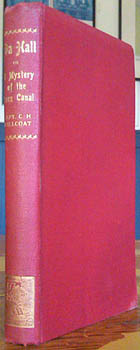
HILLCOAT, Captain C.H. [Charles Henry]. Ida Hall or a Mystery of the Suez Canal. Glasgow, David Bryce [1896]. Narrow octavo publisher's red cloth (mild signs of use). A bit canted, pretty good. Au$300
Only edition of this uncommon thriller which sees our young Miss Ida Hall of Berkley Square [sic] snatched by slavers from a Port Said hotel. Despite the thousand pound reward posted nothing has been known of her until this account. Fear not, she will be alive and well at the end of the book despite her terrible sufferings. This wasn't Captain Hillcoat's most successful book, his Notes on Stowage went through at least three editions.
Now - at the risk of drawing too long a parochial bow - can we claim some place for this in Australian literature? Captain Hillcoat (Charles Henry Lorenzo Westernra Hillcoat in full) was of a clan of emigres. His immediate family, after time in India, emigrated to America when he was a child while at least one uncle headed for Australia. His sister Cecilia joined the Australian rush in 1866 so the place was soon packed with cousins, nieces and nephews. He certainly sailed Australian waters, as the captain of the Anglo Indian in the eighties and as captain of the Futami Maru in the late nineties. His wife died in Townsville during a voyage, in 1883, and he himself died in Gosford, NSW, in 1902.
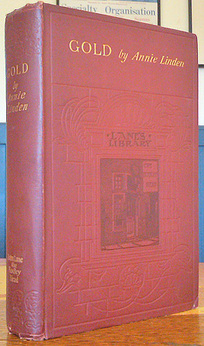
LINDEN, Annie. Gold. A Dutch-Indian Story for English People. London, John Lane 1896. Octavo publisher's decorated cloth blocked in blind; 285pp and 1896 publisher's list. A little browning; a rather good bright copy. Au$475
First edition of this rare Indonesian lost race fantasy; there was also a New York edition which looks not much easier to find. I'm not sure exactly where the dread lost land of Moa and its mountain of gold is but our explorers sail through the Moluccas on their way from Java; once we leave the Banda Islands the geography turns imaginary. Ms Linden starts slow but ends pretty ruthless; most of her worthy characters die miserably while our hero is pretty much a faithless greedy madman well before book's end.
There is enough, more than enough, local colour to convince me that first hand experience is at work here. I found mention of a couple of short stories - one about untameable half-caste women (who populate these pages too) - by Linden and one other novel, in English: a domestic drama dismissed as "Dutch fiction" in the one notice I saw; nothing else in English or Dutch.
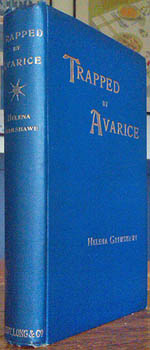
GRIMSHAWE, Helena. Trapped by Avarice. London, Digby Long 1896. Octavo publisher's blue ribbed cloth. Edges foxed, still, a good bright copy. Au$200
First edition of this most uncommon high society stew of murder, theft, fraudulent wills, gipsies and stolen children. I haven't read anything so marked by the absence of an editorial pencil and so in need of one since that model of publisher's inattention, Stoker's 'Lair of the White Worm'.
Just how did the villain have a secret gipsy mother and brother yet have an admirable father and attend a good school? How did he have a mother apparently younger than him? How did the Stanhopes sail to America in a liner decades before it was built? Decades before any such liner was built. How did Stanhope's brother spell his name? They had to yacht around the Great Lakes so that Stella could be gored by a buffalo but why did we have to read the whole itinerary? Why did the Honourable Cecil, so determined to unravel the mystery of the theft of the diamond necklace, forget to visit the jewellers for fifteen years? How could Stella and Ethel write regularly for fifteen years and each not wonder why they never had a reply? How did even a falsely accused village peasant get away with three months hard labour for the theft of the priceless necklace? And why did no-one wonder what happened to it? I have many more questions but that's enough for now.
There is supposedly a copy of a third edition of this at Newcastle (UK) but I doubt it. Helena Grimshawe - who has apparently used family records for the American parts - seems a one book author, as does Henry Grimshawe, also published by Digby Long in the same year.

HORNUNG, E.W. [Ernest William]. Irralie's Bushranger. A story of Australian adventure. NY, Scribner's 1896. Narrow octavo publisher's pale cloth elaborately blocked in dark green. A bit smudged, a couple of blotches near the end, a quite decent copy. Au$100
First American edition, contemporaneous with the English; part of the Ivory Series while the London edition was one of the New Vagabond Series. Here we meet Stingaree, the apparently well-bred bushranger, who reappears in later Horning stories. In this near farce of mistaken identity Stingaree makes the mistake of moving too far south of his usual patch, to the Riverina station of the dauntless, blue-eyed, young Irralie.
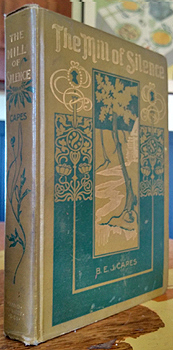
CAPES, B.E.J. [Bernard]. The Mill of Silence. Chicago, Rand McNally 1897. Octavo publisher's illustrated cloth blocked in gilt and green. A bit used, a few spots, a large owner's name on the front fly; still a most acceptable copy. Au$500
First edition of this long neglected thriller, a murder mystery soaked in horror and the uncanny, missed by bibliographers for a century. Doubtless the innocuous title and sylvan binding is partly to blame. An American book but an English story by an English writer, it was well enough described by the Star reviewer in Christchurch, New Zealand: "The author ... dearly loves the handling of the grim, the uncanny, and the morbid; he is a master in the painting of suffering humanity, suffering as a shuttle tossed by the hand of Fate." (Star, 1903, review of the later London edition). Not just humanity, our narrator can't even walk home through the woods without stumbling over a bunny "with glazing eyes and the stab of the ferret tooth behind her ear."
Secret after secret is unveiled in paroxysms of terror and hatred but babbling madness usually raises more questions than it answers. Does anyone survive the book? I'm still wondering.
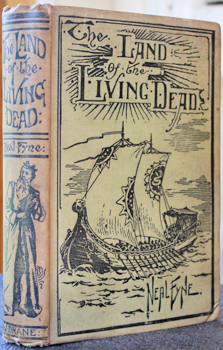
FYNE, Neal. The Land of the Living Dead A narration of the perilous sojourn therein of George Cowper, mariner, in the year 1835. London, Drane [1897]. Octavo publisher's illustrated pale green cloth blocked in black (spine a bit browned); eight plates by E.A. Holloway. A rather good copy of a book that, like many of us, resents handling and aging. Inscribed and signed by Fyne. Au$1250
First edition; a South Seas lost race thriller and hardly utopian. A ruthless godlike figure holds the power of life and death over his subjects, exploiting a decent bit of scientific investigation by someone at sometime in a sinister and lethal Wizard of Oz (or perhaps certain churches?) bit of imposture.
A couple of experts have conjectured that Neal Fyne is a pseudonym since no other books appear under that name. But a pamphlet, I suspect poem, 'In the Middle Watch' by Neal Fyne appeared in 1891 and Drane advertised, in 1897, that ''The Fulfilment of the Prophecy and Other Stories by Neal Fyne, Author of "The Coffin Shop," "Land of the Living Dead," etc. etc.'' was in the press. This is not necessarily a lie; the press could well be the cupboard in the corner where dubious manuscripts were kept. Neither does it prove the pseudonym notion either way. The inscription here doesn't help: it shows only that Fyne was not giving anything away if that wasn't his name.
By the way, if you type the phrase "land of the living dead" into Trove's newspaper search you will find a 1945 letter describing Sydney suburb Artarmon as the land of the living dead.
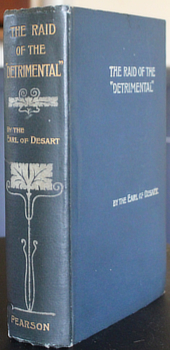
[CUFFE, William Ulick O'Connor]. The Earl of Desart. The Raid of the "Detrimental". Being the true history of the great disappearance of 1862; related by several of those implicated ... London, Pearson 1897. Octavo publisher's decorated cloth blocked in gilt and white. A hint of browning; quite good. Au$300
Only edition of this lively high society/South Seas/feminist/lost race fantasia which sees a clutch of England's finest damsels kidnapped by well bred wastrels and yachted away to a South Sea island. Soon they come across the less necessary half of a race, seemingly of Mediterranean origin, whose women leave all men between childhood and dotage on another island and visit once a year. Our aristocratic bandits discover that being British and useless is useless when young women can have their choice of good looking capable men. It's only short step to a polygamous queendom.
This seems to result in a mulitude of children. I suspect that Desart didn't think through the mechanics of woman run polygamy but perhaps I misjudge him. Without the usual British infant mortality rate there might not be an impossible number of kids.
This was, I think, Desart's last novel. I couldn't find much in the way of reviews but I am pleased to report that the Launceston Examiner thought it "a medley of puerilities." With a tough editor Desart might be still read today. He could write fluently and entertainingly but he did get side tracked easily, sometimes forgetting what novel he was writing. His Lord and Lady Piccadilly was racing into the last bend before the home straight when he abruptly introduced a horde of new characters and turned a tragedy into a social satire for a couple of hundred pages. And he is prone to letting his cynical authorial asides overwhelm a page.
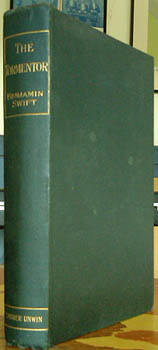
SWIFT, Benjamin [ie William Romaine Paterson]. The Tormentor. London, Fisher Unwin 1897. Octavo publisher's cloth. A rather good copy. Au$125
First edition of this mildly disappointing tragic thriller. Disappointing for fans of traditional crime thrillers fooled by the title and chapter headings. But we are given poison and death and any book that received reviews like, "Its story is unwholesome and its style deplorable. One hates to receive such a book for review, for it is filled with darkness, meanness and crime," can't be without value.
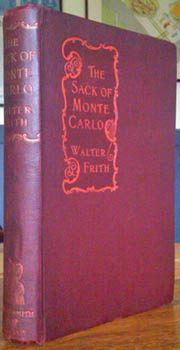
FRITH, Walter. The Sack of Monte Carlo. An adventure of today. Bristol, Arrowsmith; London, Simpkin Marshall 1897. Octavo publisher's maroon cloth blocked in gilt and red. The spine appears to have been retouched but still a rather good copy. Arrowsmith's 3/6 Series, no. XXIX. Au$285
First edition. Is this the first caper novel? The modern caper novel - parent to the caper film - I mean, forget Robin Hood and suchlike. Our young English gentleman narrator tells us how he, stymied in love for the while and unhappy and restless, comes up with the idea of looting the casino at Monte Carlo and sets out to enlist some chums - first among his sister's friends for some inexplicable reason, then among his own old school friends and members of his club - and rustle up a fast steam yacht for their getaway. His sister does sign up for the job.
Gentleman, and lady, burglars were thick on the ground within a few years, they must have been elbowing each other in Mayfair salons, country house ballrooms and the gaming rooms of Monte Carlo but I can't think of an earlier book having such fun with the planning, execution and scrapes of the big heist.
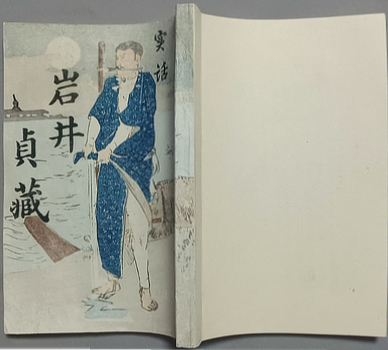
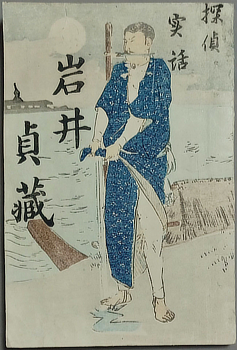
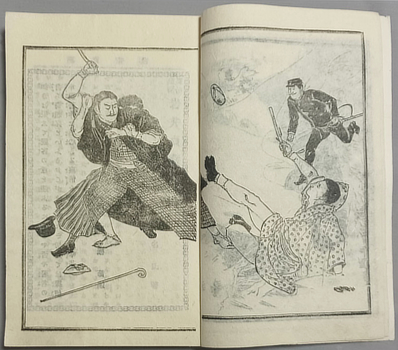
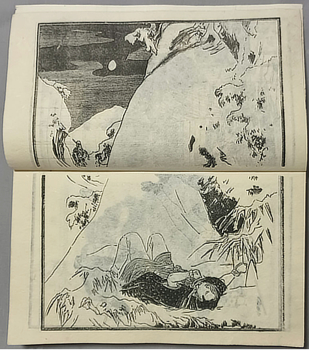

Amano Kaoru (preface). : [Tanteijitsuwa : Iwai Teizo]. Tokyo? Nakamura Sojiro 1898 (Meiji 31). 21x14 publisher's colour illustrated wrapper; three double page illustrations. With expert repairs to the spine and a new back wrapper. An excellent, fresh copy in a case by binder, writer and fastidious collector Atsuo Ikuta. Au$200
First edition. I bought this under the heading of, (roughly translated) Real life heinous murderer. We can discard the real life immediately. The preface is by Amano Kaoru, almost as obscure as anonymous, the author. I can't find a record of this anywhere but a publisher's advertisement in another book.
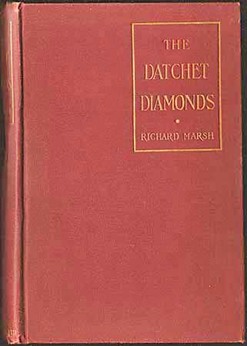
MARSH, Richard. The Datchet Diamonds. London, Ward Lock [1898]. Octavo publisher's maroon cloth; two plates by Stanley L. Wood. Some pages opened coarsely and a couple of minor blotches but still a very good copy. Au$185
First edition; a detective thriller.
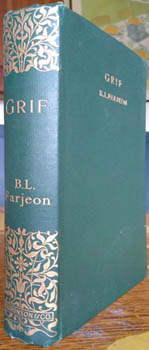
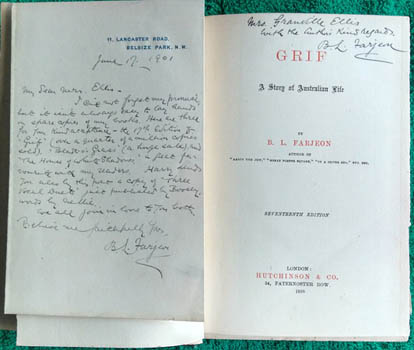

FARJEON, B.L. [Benjamin Leopold]. Grif. A story of Australian Life. Seventeenth edition. London, Hutchinson 1898. Octavo publisher's cloth, spine decorated in gilt. A little browning at the very ends, quite a nice copy. Inscribed and signed by Farjeon with an accompanying letter. Au$350
A gift from Farjeon to Mrs Granville Ellis in 1901. The short letter on Farjeon's letterhead explains that it isn't always easy to find spare copies of his books but he is sending three, including this one, and Harry - Farjeon's composer son - is sending along some sheet music just published. Mrs Ellis must be the American born journalist, Anna May (or Mai?) Bosler, who married Granville Ellis twice and wrote under the name Max Eliot. Elizabeth Pennell described her as "that awful American newspaper woman ... a vile specimen! Vulgar!" Gifted copies of Farjeon's books have a longer history than Farjeon himself. Decades later Harry used his father's own copies as school prizes.

HUME, Fergus. The Rainbow Feather. NY, Dillingham 1898. Octavo publisher's decorated cloth. A very good copy. There is a small triangular bump in the cloth on the front cover which puzzled me until I realised it was a patch applied to the inside of the cloth before binding - they weren't going to waste a foot of cloth because of a small flaw in the material. Au$165
First American edition contemporaneous with the London edition. An incredibly convoluted, even for Hume, murder mystery which begins with a cackling gipsy foretelling murder for a gorgeous but unpleasant young woman and misery for her equally gorgeous and unpleasant suitor. There is of course a twist. "And the remarkable result is that out of the thirteen active personages in 'The Rainbow Feather' ten are proved to have been present at the murder. It is pressing the credulous reader rather far, this transforming a quiet scene of assassination into a large social function." (Munsey's Magazine).
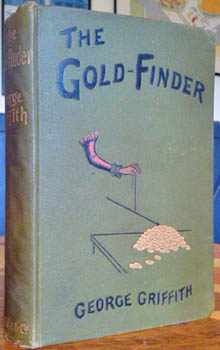
GRIFFITH, George. The Gold-Finder. London F.V. White 1898. Octavo publisher's illustrated green cloth (a bit used, spine wrinkled); frontispiece. An ok copy. Au$75
First edition of this thriller involving the Gold Magnet, high speed yachts, merciless modern piracy and tangled family secrets.
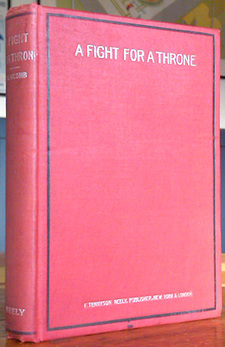
NEWCOMB, Josiah Turner. A Fight for a Throne. NY, Tennyson Neely [1898]. Octavo publisher's red cloth blocked in white and black (spine a bit darkened and rubbed). Inscribed and signed by Newcomb in December 1898. Au$400
Only edition of this scarce Pacific thriller; part lost race and part Ruritanian romance in which the exiled king and his glorious daughter must be restored to their south seas kingdom and our hero must atone for his father's crime. We won't question how the hero came across the heroine by chance on a remote Long Island beach just before his father drops dead leaving his confession of the crime that killed the queen and sent the king and baby daughter into exile in New York. Like the actual result of the self-immolating - presumably sardonic - remark of Holmes, once we have eliminated the impossible there is nothing left.
Newcomb was a New York newspaper editor at the time he wrote this, later he turned lawyer and politician; this seems to be his only book.

LAW, Frederick Houk. The Heart of Sindhra. A novel. NY, Tennyson Neely [1898]. Octavo publisher's blue cloth blocked in silver and red (spine a touch rubbed). A rather good copy. Au$200
First edition of this India set fantasy thriller with a lost city, native fanaticism and some mightily portentous dialogue.
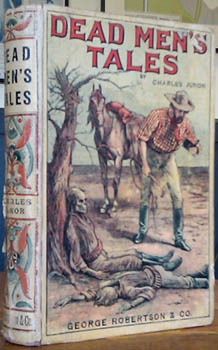
JUNOR, Charles. Dead Men's Tales. Melbourne, George Robertson 1898. Octavo publisher's colour illustrated boards (edges worn). Last leaf, a blank before the endpaper, removed, natural browning of the paper, inner hinges cracked but firm enough; certainly read but still quite a good copy. Au$1500
First edition, Australian issue; the same sheets were issued by Swan Sonnenschein. A most busy collection of tales with, within very few pages, cannibals, a ghoul in the waterhole, a vampiric leper, a death adder, a husband cuckolded by his unsuspecting companion (puzzling huh?), and a fatal curse laid on the discoverer of the remains of the two protaganists (see cover).
On to the second story - and we have photographic safeguards over a bank vault and an hypnotic burglar. Soon we are in the realm of hereditary catalepsy leading to premature burial; horrors in the tomb; a murderous husband who takes a razor to himself to prevent his dead wife meeting her suitor in the hereafter; the inadvisability of women lion tamers; Queen Victoria astral travelling to Melbourne; an Afghani ghost attending a picnic; a machine that will "read the last thoughts of a dead man's brain" ... but I give too much away.
An early reader has, in a tiny neat hand, deemed a trip between the Victorian and the Queensland borders in 24 hours as absurd. The rest passes without comment. The Australian Town and Country Journal's review probably sums up the book best: "irredemiably gruesome ... ghastly in their grim and merciless realism and ... so improbable that one is tempted to resort to the White Queen's recipe for believing impossible thlngs".
Here's an easy to believe lesson for us all from Junor: "The sudden shock to my system, caused by total abstinence, effected so seriously a decline in my physical health that my mental faculties seemed unstrung, and my intellect dislocated".
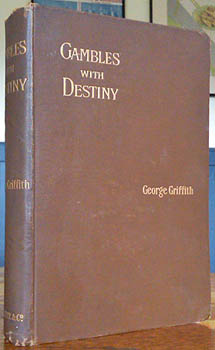
GRIFFITH, George. Gambles With Destiny. London, F.V. White 1899. Octavo publisher's cloth (tips a little worn). Endpapers spotted, a pretty good copy with Ronald E. Graham's Virgil Finlay bookplate. Au$185
First edition of this collection of shorter things, mostly sci-fi or fantasy - one of which introduces the countdown: 10, 9, 8 ...; another involves a Faustian bargain made with haschisch.
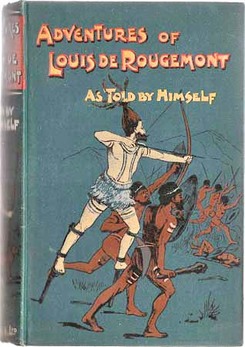
de Rougemont, Louis. [Henri Grien]. The Adventures of Louis de Rougemont as told by himself. London, Newnes 1899. Octavo publisher's illustrated cloth; 46 illustrations, some full page. A bit of a lean but an excellent bright copy. Au$200
First edition, with the preface by the editor of World Wide, Fitzgerald. I have seen copies with this removed - embarrassment after de Rougemont was definitively proved a liar? Grien did make living as 'The Greatest Liar on Earth' for a while, and likely a better living than his apparently sad true life in Australia. Once a common book but getting hard to find in decent condition.
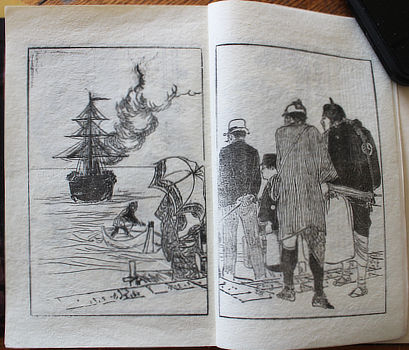
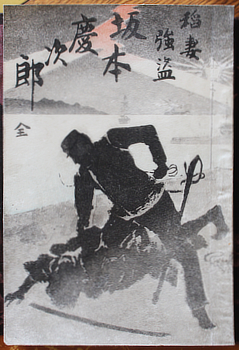
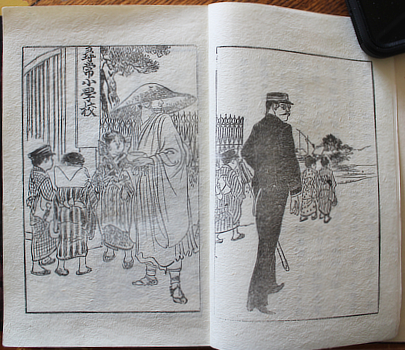
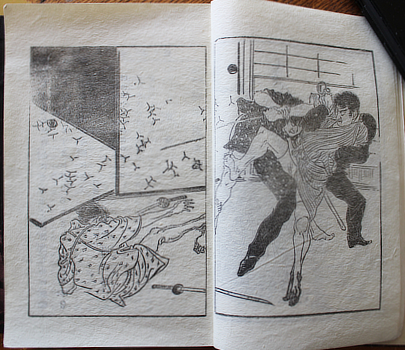

Lightning Robber : [Inazuma Goto : Sakamoto Keijiro]. Tokyo, Sanshindo 1899 (Meiji 32*). 21x14cm, publisher's colour illustrated wrapper; three double page illustrations. The wrapper and last leaf (this was not issued with a back wrapper, an advertisement leaf was joined to a stub of the cover and spine) have been repaired but I'm not sure how much. It is so near invisible. An excellent, fresh copy in a chic case by binder, writer and fastidious collector Atsuo Ikuta. Au$250
Third edition, three months after the first. The Lightning Robber - Inazuma Goto, the title of this book - was Sakamoto Keijiro, arrested in February1899 after escaping jail in 1895, a lot of robberies and three murders. This was the stuff of sensation mongering of course, plays were performed in 1897 and 1899. In 1899 four or more books called Lightning Robber appeared; that is, I found four titles but I don't know how many of them are different books.
This seems to have 24 more pages than what is likely the first edition, published by Kinshindo, and either uses the same sheets or was printed from the same plates.
*But. Those extra pages finish with his death in February 1900, months after the date on the colophon printed on the other side of the same page. Can publishers ever be trusted?
The Lightning Robber was conflated with the previous decade's Pistol Robber and one of our four or so books shows him in bowler and overcoat firing at a policeman. Japan's first feature film, 'Pisutoru Goto Shimizu Sadakichi' (pistol robber Shimizu Sadakichi) but also called 'Inazuma Goto', appeared the same year.
Worldcat does not find this version and none of their four titles are found outside Japan.
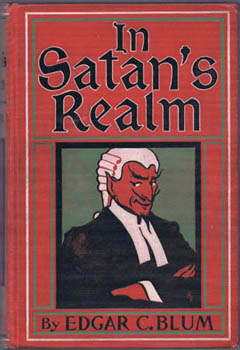
BLUM, Edgar C. In Satan's Realm. Chicago, Rand McNally 1899. Octavo publisher's illustrated red cloth blocked in green, black and white. A read copy but still quite a good copy. Inscribed by the author to a friend. Au$185
First edition. The story of a too successful journalist who begins rather than ends his greatest adventure by being eaten by a cannibal. He goes first to heaven but his 'reportorial instincts' had him quickly banished to hell.
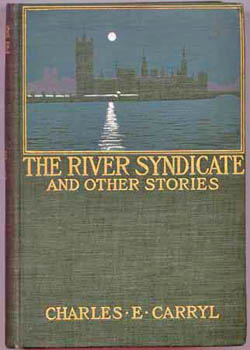
CARRYL, Charles E. The River Syndicate and Other Stories. New York, Harper 1899. Octavo, very good in publisher's green illustrated cloth blocked in gilt and colours; four plates. Au$125
First edition; detective fiction and lesser thrillers. Known for his childrens' books and poetry this is apparently Carryl's only entry into the genre.
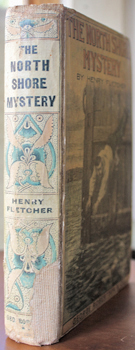

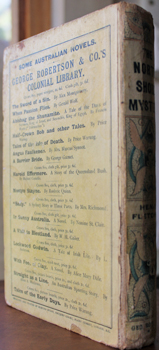

FLETCHER, Henry. The North Shore Mystery. Melbourne, George Robertson 1899. Octavo publisher's colour illustrated boards. Binding rubbed and scraped with some paper gone from the spine; paper browned. Not a bad copy. Au$750
First edition of this rare Sydney thriller, a locked room mystery for anyone who believes in the innocence of the victim's wife supposedly sleeping next to him when he was stabbed.
Despite damning it for modern readers as "almost as fascinating as Mystery of a Hansom Cab", the Adelaide Advertiser does "strongly recommend" it. The Melbourne Herald is more enthusiastic than the Sydney Morning Herald which stops just short of sneering. In Launceston (The Federalist) it is thought that those who like sensational tales of the seamy side of life will be fascinated while back in Adelaide (The Register), most worthy of remark is that the constable/detective of the novel who has a London University BA misquotes Shakespeare and has poor grammar. Returning to Sydney, the Sydney Mail first teases us with, "a strong flavouring of barmaids, bookmakers and murder" before dismissing it as "on the ordinary level of the sensational yellow-back."
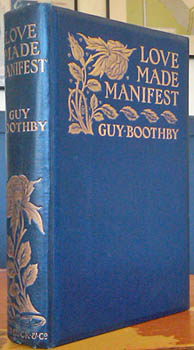
BOOTHBY, Guy. Love Made Manifest. London, Ward Lock [1899]. Octavo publisher's decorated blue cloth blocked in gilt. Endpapers a bit browned as usual, a pleasing bright copy. Au$125
First edition. From Apia to Sydney to Belgrave Square our hero wins his way to fame and fortune only to find a peril worse than any of Boothby's opium addled Asiatic fiends lying in wait for him.
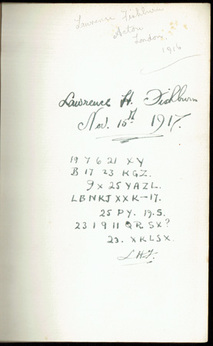
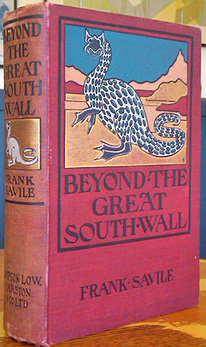

SAVILE, Frank. Beyond the Great South Wall - being some surprising details of the voyage of the S.Y. Racoon. London, Sampson Low &c 1899. Octavo publisher's illustrated red cloth blocked in black, white, gilt and blue (spine a bit faded and rubbed); [6],302pp and 10pp publisher's list included in the last gathering. A bit used, browning of the endpapers and round the edges. Inscription of a Lawrence Fishburn dated 1916 and 1917 on the front endpaper with a short message written in some secret code. Pretty good; as this is the only copy I've found after some years of looking I can't compare it to others. Au$1500
First edition and close enough to rare. George Locke noted in the first volume of his Spectrum of Fantasy (1980) that he'd traded his way up to a good first American edition but not yet seen this. At the end of volume two he announced that, in 1993, he'd seen and finally got one. These original sheets were re-issued as an undated 'cheap edition' with a cancel title page and, I suspect, sat in the warehouse for decades - the only copy of that I've seen was apparently bought new and given as a prize in 1927. In other words it was a forgotten dud. How? with that cover? who could resist it? It seems to have been better received in America where it had two editions in 1901 and received a friendly notice in the NY Times.
This is an Antarctic adventure discovering a now extinct Mayan civilization and a not extinct prehistoric monster. By no means the worst lost race novel ever written; indeed it stands proud of most Antarctic novels in being brisk, breezy and easy going.
  1 2 3 [4] 5 6 7 1 2 3 [4] 5 6 7   |